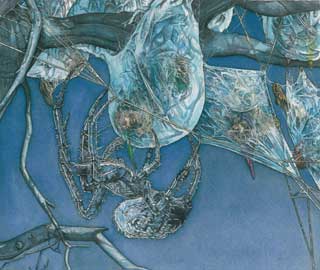Stephen Walsh has the honor of being an artist whose art can be found in hundreds of thousands of homes around the world by way of the popular board game Settlers of Catan. He’s also a well-known historical illustrator and Tolkien artist who has explored his celtic roots through his love of history and his art. We at Middle-earth Network, being big fans of his beautiful illustrations, were thrilled when he agreed to answer a few of our questions.
Tell us about your first encounter with Tolkien.
I read The Hobbit at primary school but it took me another eight years to get round to reading The Lord of the Rings. By then I was at Art College and a big fan of such graphic novels as Robert E Howard’s Conan the Barbarian. I would read Tolkien on the train journey to and from what is now Glyndŵr University. I was already a little obsessed with Celtic Mythology through my reading of Yeats in the sixth form and Tolkien’s work chimed in with this love of King Arthur and Cù Chulainn. Tolkien had set out with the aim of writing a mythology for England and it was this mythic quality that captured my imagination.
Were Tolkien’s works the first to inspire you to illustrate fantasy, or is that something that had always been with you?
At grammar school, I wanted to be an Historian and Art was at that time merely a hobby. However, during the summer following my O’levels, I discovered two books: Faeries illustrated by Alan Lee and Brian Froud, and The Studio which contained the work of Michael Kaluta and Berni Wrightson. These sparked a lifelong interest in fantasy illustration.
The first piece of epic fiction I was inspired to illustrate was W B Yeats’ Cuchulan’s Fight with the Sea. This and my Art College exhibition, The Death of Cuchulan, was part of an exploration of my Celtic roots. I then went on to illustrate works inspired by British Myths and Legends, the Gothic stories of Edgar Alan Poe and the fairytale world of the Brothers Grimm. I was in my early twenties before I got round to illustrating the works of Tolkien. The first piece I produced was an illustration of a Barrow-wight.
How did you officially break into Tolkien illustration?
Encouraged by a friend, I sent the Barrow-wight along with an illustration of a Balrog to Iron Crown Enterprises. They liked what they saw and initially commissioned three illustrations for The Middle Earth Collectable Card Game. The first piece I did for them was Flies and Spiders.
I read that your final project in school was supervised by Alan Lee; he must have been quite influential. Could you tell us about his and other artist’s influences?
My tutor at Art College was renowned Welsh artist Keith Bowen. He taught me how to be an illustrator. I still find much of his advice useful. Keith happened to be with the same agent as Alan Lee and he arranged my industrial placement with Alan. Alan suggested that I produce a finished front cover and a set of preliminary sketches for Ruth Marris’ The Sea Maiden. It was the perfect project for me being a story of mermaids and sea-monsters. Alan Lee was extremely kind to the penniless Goth student who turned up on his doorstep with his girlfriend in tow. He put us up and fed us and was very encouraging. He could not have been nicer.
Alan Lee inspired in me a love of water colour and inducted me into the English watercolour tradition, going back to Cotman and Turner. He also led me to explore the use of Celtic knotwork and illustrative borders. It was through him that I discovered Gustav Klimt, Aubrey Beardsley and Kay Neilson.
Manchester Art Gallery has a huge collection of important Pre-Raphaelite paintings. I have spent many an afternoon there. The Pre-Raphaelites have been a massive influence on my work. I know the paintings so well they are like old friends. John William Waterhouse’s Hylas and the Nymphs is my particular favourite.
Could you tell us about the significance the British countryside has lent to your Tolkien inspired illustrations?
The countryside is an integral part of the British watercolour tradition and the pre-Raphaelite school that inspires me. In many ways the Shire reflects the rural Warwickshire of Tolkien’s childhood. I live in the similarly rural county of Cheshire and its countryside is part of my psyche. My hometown is surrounded by rolling hills and gentle countryside and these often appear in my paintings. The woods at Alderley Edge, one of the possible final resting places of King Arthur’s slumbering knights, are deeply picturesque and as such a gift to the illustrator. It is this ancient woodland that appears in Flies and Spiders. Similarly, the shady woodland brook at Adlington provided the perfect backdrop for the Healing of Nimrodel.
Aside from Middle-earth themed pieces, you’re also well known for your historical pieces (and I would be remiss not to mention the ever-popular Settlers of Catan). How does your study of history inform your more fantasy-inspired illustrations?
I have always loved history and to this day I am often to be found reading some thousand page historical tome. All my work, whether fantasy or historical, springs from that love of history. It was the Art Director at Iron Crown, Jason O. Hawkins who suggested that my work might be suitable for the Catan games. It was a fruitful relationship and we ended up producing eight games together. With Catan, as with Tolkien, I ground my work in historical facts and build on them.
A sword or piece of armour has to be functional to be believable. Tolkien’s Lord of the Rings was a history of an alternative Dark Ages Europe, in illustrating Tolkien I adopt a similar approach. My work with Osprey Publishing has enabled me to develop a good working knowledge of historical costume, for fantasy pieces I embroider upon the facts to create something fantastic.
Besides illustration, what other interests and hobbies take up your time?
I love what I do and my hobbies revolve around this. I read lots of history books, attend historical re-enactments and visit historic properties with my family, who luckily share my enthusiasms.
You can find out more about Stephen Walsh at his website, http://www.stephenwalshillustrations.co.uk/, and be sure take a look at all of the different subjects that inspire him. His passion for history, authenticity, and beauty is unmistakable. Thank you, Stephen, for sharing your time and your stories with us.





One Comment